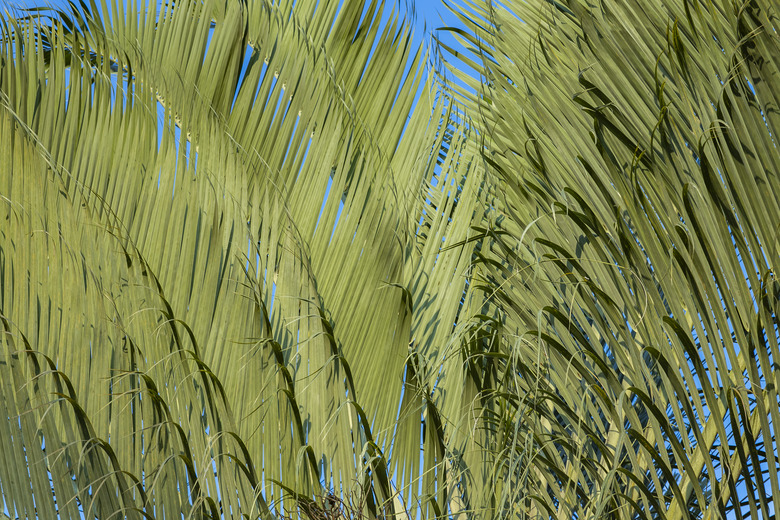Care Of Triangle Palm Trees
Triangle palms (Dypsis decaryi) add that tropical feel to the landscape. Its common name describes the appearance of its blue-green fronds, with leaf stems (petioles) forming a triangular shape at their base and growing from the top of the trunk in stacked and overlapping rows of three, which also form a triangular shape.
This single-stemmed palm grows to 20 feet tall with a 12- to 15-foot spread. The triangle palm growth rate is moderate, at the rate of 12 inches a year, according to Cal Poly's Urban Forest Ecosystems Institute. Its limited winter-hardy perennial range is in USDA plant hardiness zones 10 and 11, which includes southern California, southern Florida, and Hawaii.
- **Sunlight:** Full sun to partial shade
- **Water:** Water for long periods once a week when young and every other week for older trees; also drought-tolerant
- **Soil type:** Nutrient-rich soil, prefers close to neutral pH
- **Fertilizer:** Use palm fertilizer in April, June and August; apply extra if yellowing
- **Pruning:** Infrequent, only cut off fronds if yellowing or dead
Provide Sufficient Water
Water the tree for long periods once a week when young and every other week for older trees. Spread the water in a 3- to 6-foot diameter of the trunk, as the root system spreads far. Cut watering back to once a month in early winter to prevent the tree from freeze damage.
Use Specially Blended Palm Fertilizer
Apply a palm tree fertilizer in April, June and August. Follow manufacturer's directions on how much to apply for the size and age of the tree.
Apply an extra dose of palm fertilizer if the tree develops yellowing in the crown, yellowing or bleaching to the fronds or spots on the fronds that just do not look normal. These are signs of a nutritional deficiency, generally a potassium depletion, usually caused by using a general-purpose fertilizer not made especially for palms.
The University of Florida IFAS Extension notes that you may have to stick to a regular fertilizing regimen; otherwise, triangle palm's fronds will continue to turn yellow. Performing a soil test — or having it done for you by your local Cooperative Extension Service — accurately diagnoses any nutritional deficiencies or excesses, and eliminates the guesswork for how much fertilizer you need to give your triangle palm.
If the tree develops yellowing in the crown, yellowing or bleaching to the fronds or spots on the fronds that just do not look normal, apply an extra dose of palm fertilizer.
Observe Proper Pruning Techniques
Cut off palm fronds that are yellowing or dead as close to the stem as possible, using a ladder and long-handled pruners. Avoid pruning broken fronds as long as they're green, because they gather nutrition for the tree and cutting them off will leave the tree weak.
Do not try to climb the tree to remove dead fronds. You can get hurt or damage the tree. If it is too high for you to reach, call a professional such as an arborist.
| Sunlight | Full sun to partial shade |
| Water | Water for long periods once a week when young and every other week for older trees; also drought-tolerant |
| Soil type | Nutrient-rich soil, prefers close to neutral pH |
| Fertilizer | Use palm fertilizer in April, June and August; apply extra if yellowing |
| USDA Hardiness Zones | 10-11 |
| Growth | 20 ft tall, 12-15 ft spread |
| Pruning | Infrequent, only cut off fronds that are yellowing or dead |
Best Uses and Locations for Triangle Palms
In its native Madagascar, triangle palm is endangered because of the prolific harvesting of its seeds. Without the ability to propagate itself through seed dispersal, the trees are becoming more scarce in their native habitat.
Because it's drought-tolerant, this palm often is used as a planting in buffer strips along the highways in the U.S. As an ornamental, triangle palm graces many landscapes, and it's especially effective when planted as a focal point that features its gracefully arching fronds.
As a landscape specimen or container plant, it flowers in springtime by producing a 5-foot-tall flower stalk near its base that's covered in small, yellow flowers. When the flowers fade, a profusion of egg-shaped fruits soon follow, maturing from green to yellowish-white.
Triangle palm grows best in full sun to partial shade on nutrient-rich soil with regular irrigation, although mature plants are drought-tolerant and adapted to growing on poor soils. It's not fussy about soil type but prefers a soil pH that's close to neutral, only slightly acidic to slightly alkaline.
